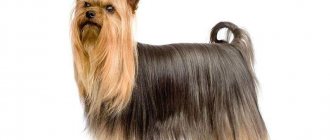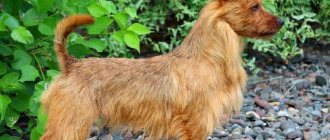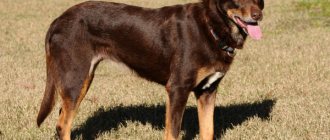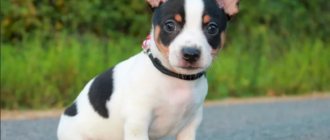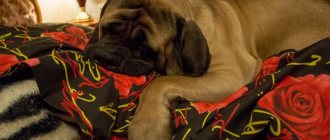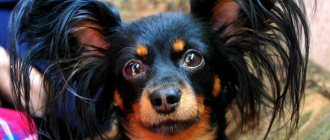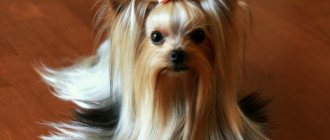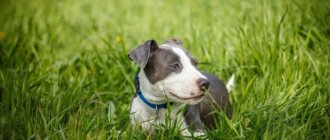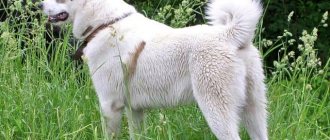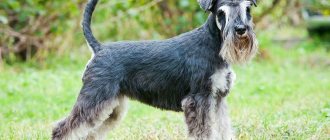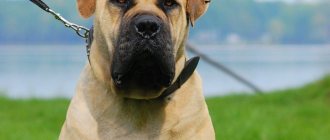History of the Australian Silky Terrier breed
The Australian Silky Terrier is a typical representative of the glorious family of hunting dogs. They began to be bred to catch small burrowing animals and exterminate mice. Over time, practical use faded into the background, and beauty and ease of maintenance became more important.
The closest relatives of the silky terrier are the Yorkshire and Australian wirehair. The breed is believed to be descended from a dog from Tasmania that was crossed with a Dandie Dinmont Terrier native to Britain. Their puppies were taken to Australia around 1825. The owner of the dogs decided to breed a new type of terrier with soft bluish fur.
The compact breed quickly gained popularity among Australians. But at first the Silky Terrier was not separated from the Australian Wirehair. At exhibitions they were presented in the same class.
The Australian Silky Terrier gained recognition as an independent breed at the beginning of the 20th century. Since the Sydney Club was involved in breeding, for more than fifty years these dogs were called Sydney Snares.
A special prize was established for the best breeders of the Australian Silk Terrier. They were rewarded with a gold bar. It was awarded to the owner of the dogs that had won the Royal Dog Show in Sydney for three years in a row.
Only in 1959 the breed was given its modern name - Australian Silky Terrier. The new standard, adopted at the same time, has remained almost unchanged since then.
History of the origin of the species
From the etymology of the name one can judge that the birthplace of this breed is Australia. But there are still disputes. Since the Australian continent was a British colony, the terrier was most likely brought from England at the beginning of the 19th century. According to official information, the closest ancestors are the Yorkshire and English terriers.
The appearance of the Australian was constantly changing: at first he looked like his brothers, but as the blood mixed, he acquired his own unique appearance. Unlike its close relative, the Silkie Terrier, the Australian has hard, spiky hair, because it was bred for work: catching rats, small rodents and snakes. Thanks to his good reaction and sense of smell, he can sense danger from a great distance and inform his owner.
The first mention of these dogs dates back to 1820. Although the breed was first demonstrated much later in Melbourne (the center of the Australian state of Victoria) as a medium terrier. Silkies with soft, silvery fur were considered the standard. Australians with their reddish color were discriminated against until 1902. They were officially registered in 1933 by the British Canine Organization, and received worldwide recognition only in 1962.
Australia is considered the official homeland. This dog is a treasure here, so the removal of puppies is not free. Permission must be obtained.
Appearance of the Silky Terrier breed
As already mentioned, the appearance of the Australian Silk Terrier is very similar to the more famous and popular Yorkshire Terrier. However, the relative from Australia is slightly larger than the Yorkie. In addition, this dog breed has a much longer body and slightly shorter limbs. The format of the snare is moderately stretched.
The height of Australian Silky Terrier males is from 23 to 26 cm. Weight is up to 5 kg. Bitches are somewhat smaller.
The Silky Terrier is a compact and proportionally built dog with strong bones.
His head is strong and of medium length, the skull between the ears is quite wide. The transition between the forehead and muzzle is clearly visible. The muzzle is slightly longer than that of a Yorkie, the nose is black.
The head should be covered with fine and long hair, but it is not advisable for the hair to fall over the eyes or cheekbones. The eyes of the Australian Silk Terrier look like slightly elongated dark beads. The dog's gaze is intelligent and a little wary. Small triangular ears, covered with short fur, stand high.
The neck is of medium length and slightly arched. The back is level, a strong loin ends with an upward-pointing tail, darker in color than the body. It is not curled or adorned with long hair. Usually the tail is docked at 2/3 or 2/5 of its length.
The limbs of the Australian Silky Terrier breed are straight and strong with well-developed muscles, covered with medium-length hair, without adorning hair. The paws are small, similar to a cat's. The claws are dark, preferably black.
The dog moves easily and springily, runs freely and quickly, as is typical for terriers.
One of the main characteristics of the breed is its beautiful long (up to 15 cm on the body) coat. As the name suggests, it should be like silk: soft and flexible. The hair lies close to the body and forms a parting along the entire body. The impression is that the Australian Silky Terrier is wearing an elegant coat of an original color.
The standard coat color is blue-blue or gray-blue. The base color starts at the back of the head and ends at the base of the tail. Fawn or golden brown tan highlights the ears, muzzle, cheekbones, and limbs. The tones should be saturated. Dark brown or black hairs in a blue coat are a fault.
The standard does not recognize a completely silver color, nor does it recognize black or white. The Australian Silky Terrier breed has special requirements for the quality of its coat. It should only be straight and smooth, flowing like silk. Tousled, curly or wavy, harsh or short is not acceptable.
Exterior disadvantages include:
- Too large or, conversely, small size
- Not black nose
- Too light eyes and claws
- Short neck with dewlap
- Awkward movements
- Disproportional physique.
A significant defect is a sunken or hunched back. Aggressive or overly fearful dogs are subject to disqualification.
Personality of the Australian Silk Terrier
The Australian Silky Terrier, as stated in the standard, should be the personification of vigilance, courage, as well as energy and strength. Small dogs have great dignity. They perceive the owner not as a ruler, but as an older comrade and leader of the pack. It is impossible to conquer a Silky terrier; you need to make friends with him and earn his respect.
Terriers with silky fur have a balanced character. They do not fall into hysterics like representatives of other mini-breeds; they are not so pampered and passive. These babies are very curious creatures. They will definitely stick their nose into all the holes. Don't be surprised when the handsome snare starts digging the ground like a small bulldozer. And if there is a mouse in the house, it will open the hunting season.
The Australian Silk Terrier is a friendly and loyal dog. He understands perfectly what is wanted from him and easily masters commands. This dog will be a good friend for a teenage child. She is ready to tolerate small children. The snare will also get along well with other pets, but it has an innate dislike for rodents.
The dignified Australian Silky Terrier can show character when meeting other dogs, especially on its own territory. A dog can behave cockily, even if the opponent is several times larger than him. Then the owner will have to stand up for the pet. And to prevent such problems from arising, the puppy needs to communicate more often with other four-legged animals.
Breed traits
Breed traits (on a 5-point scale)
| Australian Terrier | |||
| Activity | in the house | 3.5 | |
| on the street | 4.5 | ||
| Obedience | training | 4 | |
| strangers | 4 | ||
| Domination | in family | 1 | |
| over dogs | 2 | ||
| Defending your territory | from people | 2.5 | |
| from dogs | 3 | ||
| Sociability | in family | 5 | |
| with strangers | 4 | ||
| with dogs | 4.5 | ||
| Concentration | in family | 1 | |
| in front of strangers | 1 | ||
| with dogs | 1 | ||
| Aggressiveness | in family | 1 | |
| to strangers | 1.5 | ||
| to the dogs | 1 | ||
| to cats | 1 | ||
| Family behavior | calmness | 5 | |
| demand for affection | 3.5 | ||
| excitability | 3.5 | ||
| playfulness | 4 | ||
| excessive barking | 3.5 | ||
| behavioral breakdowns | 1.5 | ||
| Tolerance for children | up to 4 years | 5 | |
| over 4 years old | 5 | ||
| Institutional use | watchman | 5 | |
| bodyguard | 2 | ||
This breed is often compared to the following dog breeds: Australian Shepherd (Aussie), Border Terrier, Australian Cattle Dog (Blue Heeler), Norwich Terrier, Akita Inu.
The photo shows what Australian terriers look like:
Pros and cons of the Australian Silky Terrier breed
Like every dog breed, the Australian Silk Terrier has its own advantages and disadvantages. The future owner, fascinated by their beauty, must take into account that these are not glamorous, sluggish dogs, but temperamental and life-loving creatures.
Pros of the Silky Terrier:
- Compact dimensions
- Doesn't shed
- Wool without smell
- Sociable character
- Active and energetic
- There is no aggression towards people
- Alert, will warn of the appearance of strangers
- Can catch mice.
The cute snare has some disadvantages:
- Delicate fur needs constant care
- A dog needs to be trained from childhood
- Doesn't cope well with loneliness
- Needs active play
- Can be cocky and show his temper.
With the right approach, some of the disadvantages can easily be turned into advantages. For example, training can be an exciting process for the owner and his dog.
Education and training
Australian Silky Terriers have a typical temperament for this group of dogs. Long selection aimed at maintaining decorative qualities could not destroy their cheerful and positive character. Silks learned to live with a family, but remained independent hunters. This must be taken into account when choosing this breed of dog.
The future owner must be ready to start raising the puppy from the very first days. The baby evokes affection and a desire to indulge his whims, but you cannot give in to him.
The silky dog will quickly turn into a domestic tyrant if everyone allows him to. A poorly behaved terrier sleeps in his master's bed and eats from his table.
If you do not want to correct the shortcomings of upbringing, immediately accustom your pet to a routine. You need to start with the simplest commands and skills: accustom him to a nickname, place, walks. The first litter box for small snares may be a cat litter box or diaper.
Then learning more complex commands. Australian Silk Terriers are easy to train; from childhood they are prepared for performances in the show ring.
If the dog will not be shown, you can go through a general training course with it, of course, adjusted for its small size. Silks are excellent at mastering agility techniques; they love to run and are quite fast.
Small terriers will benefit from group training and activities at the dog park. Early socialization will help tame the snare's cocky temperament.
Character and behavior
The Australian Terrier is a hardy and courageous dog, hardened by harsh living conditions. Representatives of the breed have excellent instincts and lightning-fast reactions. The developed guard instinct turns them into good guards.
Australian Terriers have a cheerful, friendly, cheerful character and temperament. They are obedient, balanced and very devoted to their owner, which makes pets excellent companions.
Australian Terriers are not recommended to be kept with other pets. They consider all small animals to be hunted. On walks, clashes with other dogs are possible, since many representatives of the breed are quite pugnacious.
If there are small children in the family, you will have to be careful. Australian Terriers do not tolerate disrespect, so playing together must be done under adult supervision. But the pet will probably get along well with a teenager - they will be able to spend many hours in a row engaging in active entertainment.
Care and maintenance of the silky terrier
The Silk Terrier can live in a yard or enclosure only in warm climates. A harsh winter is a serious test for such a baby.
The Australian Silky Terrier is best suited for living in an apartment. He does not require much space, he has no undercoat and seasonal shedding. And his hair does not emit the characteristic dog smell.
This dog loves active walks. It is not necessary to spend 3-4 hours on the street with him, it is more important to let him run around and play to his heart’s content. Then at home the snare will behave like a silk one.
Caring for an Australian Silky Terrier includes the usual hygiene procedures: cleaning ears and teeth, rubbing eyes, trimming nails.
Special attention – wool
The terrier's magnificent silky coat requires a lot of attention. It quickly becomes dirty and tangles form on it. However, snare lovers claim that the fur of their pets is much easier to care for than that of Yorkies.
The owner should wash and comb the dog at least once a week. To prevent your beauty from fading, you need to use a special shampoo and conditioner that suits your hair type. After washing, be sure to dry the coat with a hairdryer and comb it with a massage brush and then with a comb.
Breeders of the breed categorically do not recommend combing dirty or dry hair. To combat mats, you need to use zoospray. They spray the problem area with it, and then sort out the tangled fur with their hands.
Feeding
At first, the Silky Terrier puppy needs to be provided with the food that he is accustomed to in his parents' home. Switching to a new diet is a serious test for a baby. Consult the breeder what he recommends feeding the dog. After a month or a month and a half, when your dog has settled in, you can gradually change the menu. Experienced dog breeders do not recommend mixing dry food and natural food. Choose one thing.
Snares are suitable for premium ready-made food for small breeds. Pay attention to the composition, whether there are any obvious chemicals there, and whether this diet is suitable for a long-haired dog.
Don't forget about your drinking regime. With any type of feeding, fresh water should be available to the dog around the clock.
If you prefer natural feeding, resist the temptation and do not treat your terrier with food from your table. Sausages, smoked meats and sweets are extremely harmful for animals; you should not feed pork (in any form), legumes and starchy vegetables. Also avoid bones, especially tubular ones. They can injure the dog's gastrointestinal tract.
Approximately 30-40% of the diet should consist of cereals (buckwheat, oatmeal, rice and the like) with vegetables. It is advisable to minimize heat treatment. Steam the porridge, lightly boil or stew the vegetables.
The rest of the menu consists of protein products of animal origin: lean beef, lamb, turkey, offal, sea fish fillet, cottage cheese, boiled eggs. Give some seasonal fruits and berries as a vitamin supplement and treat.
Dog care
Dogs of this breed are quite unpretentious in this regard.
The most important thing is to take care of the fur and maintain its neat appearance by brushing it regularly. Special shampoos are used for washing.
These terriers do not require any special haircuts. You just need to trim the area near the eyes and ears for their comfort.
- The owner is obliged to fully satisfy the pet's needs for active recreation.
- If you don't give your dog as many games and walks as he needs, he will become bored, languid, and his mood will drop significantly.
- He may even start acting up and acting out to show the person how bored he is.
Health and illness
The Silky Terrier is usually a strong and healthy dog. But the breed has a hereditary predisposition to certain diseases.
Movable snares may suffer from dislocations. In adults, diabetes mellitus occurs. Another vulnerable spot is the eyes. Retinal diseases and cataracts are detected in Silky Terriers.
These anomalies are inherited. Conscientious breeders, in order to exclude health problems, examine the couple before mating. For example, in Finland, the USA and Sweden, an eye test and a check of the knee caps are mandatory procedures for Silk Terrier dogs that are being prepared for breeding.
There is no national club for the Australian Silky Terrier in Russia yet. Therefore, such requirements have not been introduced.
Vaccinations and susceptibility to disease
The Australian Terrier is vaccinated at 8-9 weeks with a complex vaccine against the most dangerous diseases. After 21 days, the puppy is revaccinated. The rabies vaccination is recommended at 6-7 months, when the teeth change. Adult dogs are vaccinated every year.
Australian terriers are distinguished by excellent health. However, due to the structural features of the skeleton, they may develop hip dysplasia, a hereditary disease of the musculoskeletal system. Therefore, before purchasing a puppy, you should familiarize yourself with x-rays of the parents’ limbs.
In rare cases, Australian Terriers are diagnosed with:
- diabetes;
- epilepsy.
On average, Australian Terriers live 13-15 years.
How to choose a puppy
If you want to get a dog, carefully consider all the consequences of such a decision. We must not forget that this is a living creature that you will have to take care of throughout its life.
When choosing an Australian Silky Terrier puppy, remember that this breed is not a decorative toy. A small dog will have to be trained, otherwise it will show the worst terrier qualities. Be sure to read reviews from owners on forums, go to exhibitions to see terrier snares and watch them.
If you are not disappointed in the breed, determine whether you will show your pet or whether you need a loyal and cheerful friend without medals and awards. In the first case, you need to purchase a puppy only from a reliable breeder and pay special attention to compliance with breed standards.
Australian Silky Terrier puppies are born black and tan, the blue color should only be indicated. This is a sign that the adult dog will acquire the correct color. By about a year or a year and a half, “reblooming” occurs.
The owners of the nursery where you will take the puppy must issue documents confirming the breed and provide recommendations for care, feeding and education. If you do not need a show dog, but a companion for the soul, you can opt for a puppy without documents. Sometimes babies with defects are sold by breeders. They look like a snare terrier, but to the dog community they are mixed breeds.
When you have found where to buy a puppy, you need to choose it correctly. Observe your future pet before making a decision. Pay attention to the most well-fed, curious and active. As a rule, such a kitten is in better health.
Dog food
When purchasing a dog, ask the breeder about its diet. From an early age, puppies develop one constant diet that will need to be maintained.
In general, there are two ways: store-bought ready-made food and regular hand-cooked food. As for the second, Australian Terriers are prohibited from giving:
- Sausage and dried meat;
- Legumes, cabbage;
- Baked goods and sweets;
- Bones (feeding them is not strictly prohibited, but it is better to do this rarely, as a special treat).
Don’t forget about a bowl of clean water, the fullness of which is important to regularly monitor.
How much do Australian Silky Terrier puppies cost?
The Australian Silky Terrier is still a very rare breed for Russia. Therefore, puppies from good producers and with a pedigree cannot be cheap. You can buy an Australian Silky Terrier puppy for an average of 35-50 thousand rubles.
But if you like this dog, try to find a dog lover. Puppies without documents cost several times less. Just be sure to meet the future student’s mother. This way you can make sure that the dog does not grow up to be huge and not at all like a snare terrier.
